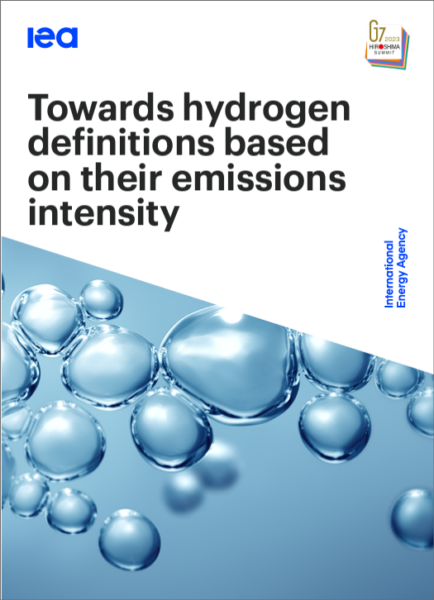The International Energy Agency (IEA) released the report “Towards hydrogen definitions based on their emissions intensity”, which assesses the greenhouse gas emissions intensity of different hydrogen production routes and reviews ways to use the emissions intensity of hydrogen production in the development of regulation and certification schemes. It was designed to inform policy makers, hydrogen producers, investors and the research community in advance of the G7 Climate, Energy and Environmental Ministerial meeting in April 2023.
Hydrogen is attracting attention as a next-generation energy source. At the Fifth Hydrogen Energy Ministerial Meeting held on September 26, 2022, more than 20 countries and regions, including Japan, set a goal to increase global hydrogen production to 90 million tons per year by 2030 by using low-carbon technologies (such as electrolysis of water using renewable energy). This new target is equivalent to 45 times the current amount of domestic hydrogen production of approximately 2 million tons. It is clear how much hydrogen is needed, and so in order to produce and secure this quantity, the establishment of an international supply chain is urgently necessary. However, there is no specific standard for what type of hydrogen is considered “clean” among the various “rainbow-colored” hydrogen types, each of which refers to a particular production route. Without a well-defined classification of how different types of hydrogen are produced, there is concern that companies and investors may be deterred from investing in hydrogen projects. The IEA warns that the lack of a clear regulatory framework and/or certification would delay final investment decisions on hydrogen with low or no GHG emissions during its production process.
Highlights from the report
- Hydrogen is an important part of today’s energy sector, with 94 Mt of demand in 2021 concentrated in refining and industrial applications. The G7 accounts for around one-quarter of global demand. Demand in new applications that could be key to fully decarbonising the entire energy system remained limited to around 40 000 t in 2021.
- Hydrogen, ammonia and hydrogen-based fuels can support the decarbonisation of the global energy system, particularly in heavy industry and long-distance transport. This will require a step-change in demand creation, particularly in new applications; in the IEA’s Net Zero Emissions by 2050 Scenario (NZE Scenario), global demand from such applications reaches more than 300 Mt by 2050.
- The production of hydrogen today is based predominantly on unabated fossil fuels. Low-emission hydrogen production is more costly, but scale-up and technology innovation can make low-emission hydrogen competitive in the short term in regions with abundant renewable resources or access to cheap fossil fuels and geological CO2 storage.
- Regional cost differences and growing demand in regions with less potential to produce low-emission hydrogen, including some G7 members, and the need to diversify fuel supply in the wake of the global energy crisis, could require the development of an international hydrogen market to trade hydrogen, ammonia and hydrogen-based fuels, despite the additional costs arising from conversion and transport processes.
- The deployment of large-scale projects for the production of low-emission hydrogen, ammonia and hydrogen-based fuels is facing important bottlenecks. Only 4% of announced projects (with a total production capacity of almost 1 Mt of hydrogen) are under construction or have taken a final investment decision. Lack of clarity in regulation and certification, lack of infrastructure to deliver hydrogen to end users, and uncertainty about future demand are important impediments.
- G7 members have a critical role to play in scaling up production and use of low emission hydrogen, ammonia and hydrogen-based fuels globally, and in the development of international supply chains, given their economic power, climate goals and leadership in technology innovation. Nonetheless, the successful development of a global hydrogen market will require an inclusive dialogue with other stakeholders, including producers and emerging economies.
As an example, production based on unabated fossil fuels can result in emissions of up to 27 kg CO2‑eq/kg H2, depending on the level of upstream and midstream emissions. The average emissions intensity of global hydrogen production in 2021 was in the range of 12-13 kg CO2‑eq/kg H2. In the IEA Net Zero by 2050 Scenario, this average fleet emissions intensity reaches 6‑7 kg CO2‑eq/kg H2 by 2030 and falls below 1 kg CO2‑eq/kg H2 by 2050.
Although environmental impact and sustainability as well as economic efficiency are important in the production and use of hydrogen, the IEA does not provide a generally accepted upper limit for the emissions intensity of hydrogen production in this report. Alternatively, it calls on governments to “define roadmaps to decarbonise hydrogen production, both domestic and imported, in accordance with their national circumstances” and develop an internationally agreed emissions accounting framework to use as a useful tool not only to provide the necessary transparency, but also to promote interoperability, reduce market fragmentation, and enable investments to develop an international hydrogen supply chain.
In Japan, the government is reviewing its Basic Hydrogen Strategy (written in Japanese), which is expected to be finalized at the end of May. In this strategy, the government is planning to consider increasing the hydrogen supply 6x from the current 2 million tons to 12 million tons by 2040. Japan, which relies on imports for most of its fuel, will face risks not only regarding maintaining a stable supply but also on price fluctuations when it is not able to obtain hydrogen produced from domestic renewable energy sources.
Related Links
Towards hydrogen definitions based on their emissions intensity(Link)
Executive summary(Link)
Written/Published by: International Energy Agency (IEA)
Published: April, 2023

